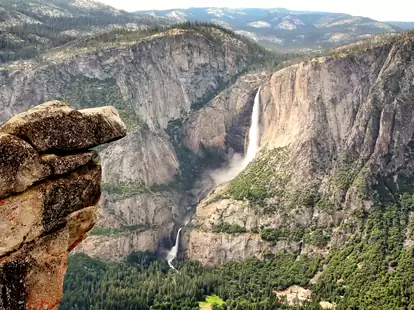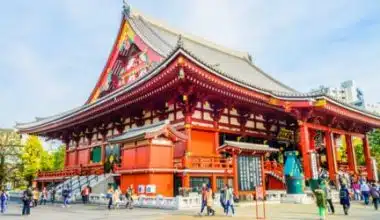The majestic granite cliffs and domes, towering sequoias, and deeply carved valleys that can be found in Yosemite National Park make it one of the most beautiful national parks in the United States. But it can be confusing to decide what best time to visit Yosemite.
Here is a quick travel guide to help you decide when the best time to visit Yosemite is regardless of what your plans or preferences are.
Let’s jump right in…
Overview
Yosemite National Park is one of the most breathtaking places on Earth. Giant sequoia groves dot the landscape, granite monoliths protrude from the ground, and waterfalls cascade down cliff faces. The park encompasses 747,956 acres, or 1,169 square miles, of nearly unspoiled wilderness; exploring it would take a lifetime. Hundreds of black bears and over 400 other vertebrate species (including fish, reptiles, birds, and mammals) call this expansive wilderness home.
Even though a weekend or a week in Yosemite isn’t enough time to see everything, the park will still leave an impression. It’s time to start making plans to visit Yosemite in person when you’ve had it with your Half Dome screen saver and webcams. The park is surprisingly easy to get to, being only about an hour’s drive north of Fresno and about three hours from both San Francisco and Sacramento.
Yosemite through the Year
Yosemite National Park in the Spring
The Yosemite Valley is most enjoyable in the spring. Waterfalls are spectacular in May, when wildflowers are also in full bloom and summer visitors have yet to arrive. Daytime highs are usually in the glorious range, but cool evenings are to be expected.
Access to Tuolumne Meadows and Glacier Point is limited in the early spring (March, April) because Tioga Road and Glacier Point Road remain closed due to persistent winter snow. Both roads usually open by the end of May, but in years with a lot of snow, they may not open until June.
Yosemite National Park in the Summer
Yosemite sees the most tourists in the summer. Due to the park’s beautiful scenery and warm summer weather, it is frequently visited by families on vacation.
However, Yosemite Valley can become overcrowded and congested with visitors on many summer weekends. By the middle of summer, many of the Valley’s renowned waterfalls have dried up, and daytime highs can reach the 90s.
For these and other reasons, the most astute Yosemite tourists spend their summers in Tuolumne Meadows. Tuolumne Meadows (8,600 feet) is cool and quiet, while Yosemite Valley (4,000 feet) is hot and crowded. The beautiful trails of Yosemite’s High Sierra can also be reached quickly from Tuolumne Meadows.
Yosemite in the Autumn
Yosemite Valley is especially beautiful in the fall. After Labor Day, daytime temperatures drop, and the crowds thin out significantly. Therefore, September is a fantastic month to visit Yosemite Valley for outdoor activities like hiking and rock climbing.
Meanwhile, in September, Tuolumne Meadows experiences cold nights and cool days. Tioga Road is closed for the winter after the first heavy snowfall, which typically occurs between the middle of October and the middle of November, and services end at the end of September.
Even the largest waterfalls in Yosemite Valley have diminished to a trickle by the middle of October. However, the oaks, maples, and dogwoods have beautiful fall foliage.
Yosemite National Park in the Winter
Yosemite’s least-visited season is winter, but the park looks especially beautiful after a snowfall.
While Tuolumne Meadows and the High Sierra are inaccessible due to the closure of Tioga Road, Glacier Point Road has been plowed to the Yosemite Ski and Snowboard Area.
The Ahwahnee Hotel in Yosemite Valley hosts a number of amazing events throughout the year, such as wine tastings, Chefs’ Holidays, and the world-famous Christmas Bracebridge Dinner. Hundreds of people flock to Yosemite Valley in the last two weeks of February to see the Firefall, one of the park’s most spectacular waterfalls.
Best Time to Visit Yosemite National Park for Avoiding the Crowds
The park is open all year, but the vast majority of its visitors (75%) come between May and October, making the months of November through April ideal for those seeking peace and quiet. However, the splendor and beauty of Yosemite are still there, even in the winter. You can go on a peaceful winter hike, or you can watch the impressive Yosemite Falls flow for the first time after a rain or snowfall.
While Yosemite Valley and Wawona can be reached by car year-round, visitors should be aware that Tioga Road and the road to Glacier Point are typically closed in the month of November due to inclement weather. The Badger Pass Ski Area’s access road, Glacier Point/Badger Pass Road, is plowed by the park beginning around the middle of December and continuing through the beginning of April.
Although the park sees a rise in visitors around the holidays, January is typically the park’s quietest month, making it ideal for those looking for some solitude during their vacation.
Best Time to Visit Yosemite National Park for Camping
Yosemite’s campgrounds attract visitors from all over the world, and the park itself welcomes campers all 12 months of the year. Camping is available year-round at Hodgdon Meadow, Upper Pines, and Camp 4 in Yosemite Valley. Camping deep within the park (at White Wolf, for instance) in the winter requires special equipment that is harder to come by than in the summer.
Seasonal campgrounds in Yosemite typically open between the months of May and August. From April to September, reservations are required due to high demand.
Best Time to Visit Yosemite National Park for Driving Tioga Road
Tioga Road is the only road that goes all the way through Yosemite National Park, so it’s ideal for visitors who don’t have much time but still want to see a lot of the park. The 47-mile drive starts in Crane Flat and ends at Tioga Pass. Beautiful Siesta Lake and Tenaya Lake, as well as the massive Lembert Dome, can be seen along the way.
Tioga Road closes in the winter due to snowfall and usually reopens in late May or June, only to close again in late October or early November.
Best Time to Visit Yosemite National Park for Seeing Wildflowers
Wildflowers can be seen throughout the year in Yosemite National Park, provided that you know when and where to look, as the park’s elevation ranges from 2,000 feet in the west to 13,000 feet in the east.
Hikers can catch a glimpse of spring’s first vibrant blooms in the park’s lower elevations, such as on the Cook’s Meadow Loop in Yosemite Valley, the Wawona Meadow Loop, and the Hetch Hetchy Trail to Wapama Falls. Bright spots of color may even be visible through the snow at higher altitudes. The bright reddish-pink snow plant makes its grand entrance along the McGurk Meadow, Taft Point, and Sentinel Dome trails, all of which are accessible from Glacier Point Road.
Wildflowers abound in Tuolumne Meadows during the summer. Pink shooting stars appear in the spring, while late summer is when you’ll find columbine, fireweed, and dog violets. The highest points of the park are covered in alpine laurel, yellow mountain monkeyflowers, and angelicas in the middle of summer.
Best Months to Visit Yosemite National Park for Good Weather
Depending on where in the park you intend to spend the day, the weather can range from a low of 2,000 feet to a high of 13,000 feet. However, more than 75% of Yosemite’s annual precipitation falls between November and March and 95% between October and May.
If you want to minimize your exposure to precipitation (including snow), a trip between June and September is your best bet.
Yosemite National Park: When to Avoid It
July and August see five to six times as many tourists as the relatively empty winter months (except around the holidays, when the numbers skyrocket). The next two busiest months for the park are June and September.
Unless you want your Yosemite experience to be cut short by closed roads, trails, and campgrounds, the best time to go is between June and September, when the park is less crowded and the weather is milder.
Extra Factors to Think About
If you want to have the most amazing time in Yosemite, what else do you need to know? Make the most of your time in Yosemite by remembering these helpful hints.
- Plan a camping trip to a nearby park. Camping is a great way to save money and get a closer look at the park than staying in any of the hotels or lodges inside the park. There are thirteen campgrounds within Yosemite National Park, four of which are open all year (just remember to bring extra blankets and warm clothing in the winter). Camping in this gorgeous park is a great way to save money on lodging for your family.
- Keep yourself updated on seasonal closures. In the late fall and winter, when snow falls, and temperatures drop, Yosemite shuts down certain roads, trails, and services. The park’s only through road, Tioga Road, is closed every year from November to May. Between the months of October and April, a number of the hotels and campgrounds close for the season. Check in advance to see if the park’s free busses and shuttles will be operating before you make your way there in the winter.
- Keep in mind the necessities of tire chains. Tire chains are required from November through March (the coldest months) in Yosemite. You shouldn’t drive in the park in the winter without tire chains because of the unpredictable snow and ice conditions. Avoid the need for tire chains by visiting in the warmer months and entering at lower elevations (such as the El Portal Road) in the late fall or early spring.
Read Also: Best Places to Travel in April: 2023 Exhaustive List (Updated)
- During busy periods, reservations are required. Yosemite National Park requests that visitors who are not staying in the park’s lodging or campgrounds make advance reservations due to the high volume of visitors during peak season. From May 20 through September 30, visitors who enter the park between 6 a.m. and 4 p.m. are required to make a $2 reservation (3 days in advance) before entering the park. Please try to book your stay at least 7 days in advance. There will still be a separate admission price to pay upon arrival.
- An entry Fee is Expected. Most tourists pay $35 for a seven-day pass to Yosemite National Park that is valid all through the year. Entrance fees are $30 for motorcyclists, $20 for pedestrians and bicyclists, and free for those under the age of 15. Free annual passes for veterans, annual and lifetime passes for anyone else, Every Kid Outdoors program participants in 4th grade, and the four or five days a year when entry is free are the only exceptions. Here you can find out more information.
- Participate in as many events as possible. There is a wide variety of fun things to do and see in Yosemite for visitors of all ages and abilities. Activities such as skiing, snowboarding, ice skating, swimming, canoeing, kayaking, canoeing, rafting, fishing, rock climbing, horseback riding, bird and wildlife watching, stargazing, backpacking, camping, photography, guided hikes and tours, museum and visitor center exploration, in-park dining and picnics, and much more are all available to you during your stay. Pack as much fun into your Yosemite vacation as possible!
Related Articles
- Best Places to Visit in August 2023, Revealed (Updated)
- Best Time to Go to Cancun 2023: All You Need
- BEST DESTINATIONS FOR VACATION IN AFRICA
- 10 AMAZING WATERFALLS TO EXPLORE IN NEW JERSEY
- Best Time to Visit Hawaii 2023: Best Easy Guide






